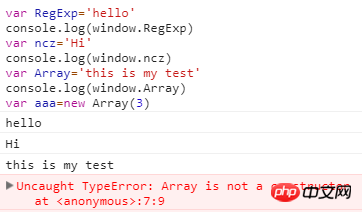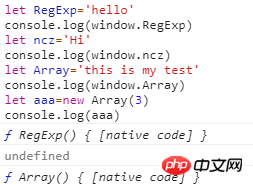Block-level scope binding in JavaScript ES6
This article mainly introduces the in-depth understanding of block-level scope binding in ES6 study notes, which has certain reference value. Interested friends can refer to it
As we all know, the var statement in js There is a variable promotion mechanism, so ESMAScript 6 references block-level scope to strengthen control over the variable life cycle
let const declaration will not be promoted, there are several points to note
1. It cannot be declared repeatedly.
Assume that an identifier already exists in the scope (whether the identifier is declared through var or let or const variables). At this time, use let or A const key declaration will throw an error
var count=10 let count=20// 此处则会抛出错误,因为同一作用域内不能重复声明
If the current scope is embedded in another scope, you can use let to declare the same name in the embedded scope. Variables
var count=10
if(true){
let count=20
}2. Constants declared as const must be initialized
If declared as follows, an error will be reported
const name;//语法错误,常量未初始化
3. You cannot assign a value to a constant defined by const. The real essence is that the const declaration does not allow modification of the binding, but allows modification of the value (that is, the const declaration After the object is created, you can modify the attribute value of the object)
const person={
name:'angela'
}
//可以修改对象属性的值
person.name='yun'
// 修改绑定则会抛出语法错误
person={
'name':'Shining'
}4. Temporal Dead Zone
When the JavaScript engine scans the code and finds variable declarations, it will either raise them to the top of the scope (var declarations are encountered), or place the declarations in the TDZ (let and const declarations are encountered), accessing the TDZ The variable will trigger a runtime error. Only after the variable declaration statement is executed, the variable will be moved out of the TDZ and can be accessed normally.
The following code is because the value is already in the TDZ when console.log is executed in the if block-level scope. In the past, typeof was a relatively error-prone operator, but it actually couldn't stop the engine from throwing errors
Accessing block-level bindings before declaration will cause errors because the bindings are in the temporary dead zone
if (true) {
console.log(typeof value)//引用错误
let value = 'blue'
}If you use typeof on the variable outside the scope declared by let, no error will be reported
console.log(typeof value)
if (true) {
let value = 'blue'
}5. Block-level scope binding
Before, creating functions in a loop was a bit unspeakable
var funcs = []
for (var i = 0; i < 10; i++) {
funcs.push(function () {
console.log(i)
})
}
funcs.forEach(function (func) {
func()
})Because of the loop All functions created internally retain references to the same variables. At the end of the loop, the value of variable i is 10, so the result will be output 10 times 10
, so everyone will use the immediate call function in the loop expression to force a copy of the counter variable to be generated so that 1, 2, 3...
var funcs = []
for (var i = 0; i < 10; i++) {
funcs.push((function (value) {
return function () {
console.log(value)
}
})(i))
}
funcs.forEach(function (func) {
func()
})With let, the function expression is called immediately It can be simplified. In fact, each iteration of the loop will create a new variable and initialize it with the value of the variable with the same name in the previous iteration.
var funcs = []
for (let i = 0; i < 10; i++) {
//其实是每次循环的时候let声明都会创建一个新变量i并将其初始化为i的当前值,所以在循环内部创建的每个函数都能得到属于它们自己的i的副本
funcs.push(function () {
console.log(i)
})
}
funcs.forEach(function (func) {
func()//这里输出是0 然后是1、2....9
})This feature also applies to for in , for example
var funcs = [],
obj = {
a: true,
b: true,
c: true
}
for (let key in obj) {
funcs.push(function () {
console.log(key)
})
}
funcs.forEach(function (func) {
func()//输出的是a b c
})6. The let declaration feature in a loop also applies to const declarations. The only difference is that const cannot change the binding
In the above example, changing let to const also outputs a b c
var funcs = [],
obj = {
a: true,
b: true,
c: true
}
//之所以可以运用for in 和for of循环中,是因为每次迭代不会修改已有绑定,而是会创建一个新绑定
for (const key in obj) {
funcs.push(function () {
console.log(key)// 同样输出a b c 唯一的区别是循环内不能更改key的值
})
}
funcs.forEach(function (func) {
func()
})The following example will report an error because it is changed in the for loop. The binding of i but const constant cannot change the binding
var funcs = []
for (const i = 0; i < 10; i++) {
funcs.push(function () {
console.log(i)
})
}
funcs.forEach(function (func) {
func()
})7. Global scope binding
When var is applied to the global scope, it creates a new global variable that acts as a property of the global object (the window object in the browser environment), which means that using var is likely to inadvertently overwrite an existing global variable

It can be seen from the code above that even the global object RegExp Array will be overwritten
But let or const will be created in the global scope A new binding, but the binding will not be added as a property of the global object. In other words, using let or const cannot overwrite the global variable, but can only obscure it

RegExp and window.RegExp at this time are different
##
let RegExp='hello'
console.log(RegExp) //hello
console.log(window.RegExp===RegExp)//false
const ncz='hi'
console.log(ncz)
console.log("ncz" in window)Best practice:
only when you really need to change the value of the variable.
The above is the detailed content of Block-level scope binding in JavaScript ES6. For more information, please follow other related articles on the PHP Chinese website!

Hot AI Tools

Undresser.AI Undress
AI-powered app for creating realistic nude photos

AI Clothes Remover
Online AI tool for removing clothes from photos.

Undress AI Tool
Undress images for free

Clothoff.io
AI clothes remover

AI Hentai Generator
Generate AI Hentai for free.

Hot Article

Hot Tools

Notepad++7.3.1
Easy-to-use and free code editor

SublimeText3 Chinese version
Chinese version, very easy to use

Zend Studio 13.0.1
Powerful PHP integrated development environment

Dreamweaver CS6
Visual web development tools

SublimeText3 Mac version
God-level code editing software (SublimeText3)

Hot Topics
 Usage of typedef struct in c language
May 09, 2024 am 10:15 AM
Usage of typedef struct in c language
May 09, 2024 am 10:15 AM
typedef struct is used in C language to create structure type aliases to simplify the use of structures. It aliases a new data type to an existing structure by specifying the structure alias. Benefits include enhanced readability, code reuse, and type checking. Note: The structure must be defined before using an alias. The alias must be unique in the program and only valid within the scope in which it is declared.
 How to solve variable expected in java
May 07, 2024 am 02:48 AM
How to solve variable expected in java
May 07, 2024 am 02:48 AM
Variable expected value exceptions in Java can be solved by: initializing variables; using default values; using null values; using checks and assignments; and knowing the scope of local variables.
 Advantages and disadvantages of closures in js
May 10, 2024 am 04:39 AM
Advantages and disadvantages of closures in js
May 10, 2024 am 04:39 AM
Advantages of JavaScript closures include maintaining variable scope, enabling modular code, deferred execution, and event handling; disadvantages include memory leaks, increased complexity, performance overhead, and scope chain effects.
 What does include mean in c++
May 09, 2024 am 01:45 AM
What does include mean in c++
May 09, 2024 am 01:45 AM
The #include preprocessor directive in C++ inserts the contents of an external source file into the current source file, copying its contents to the corresponding location in the current source file. Mainly used to include header files that contain declarations needed in the code, such as #include <iostream> to include standard input/output functions.
 C++ smart pointers: a comprehensive analysis of their life cycle
May 09, 2024 am 11:06 AM
C++ smart pointers: a comprehensive analysis of their life cycle
May 09, 2024 am 11:06 AM
Life cycle of C++ smart pointers: Creation: Smart pointers are created when memory is allocated. Ownership transfer: Transfer ownership through a move operation. Release: Memory is released when a smart pointer goes out of scope or is explicitly released. Object destruction: When the pointed object is destroyed, the smart pointer becomes an invalid pointer.
 There are several situations where this in js points to
May 06, 2024 pm 02:03 PM
There are several situations where this in js points to
May 06, 2024 pm 02:03 PM
In JavaScript, the pointing types of this include: 1. Global object; 2. Function call; 3. Constructor call; 4. Event handler; 5. Arrow function (inheriting outer this). Additionally, you can explicitly set what this points to using the bind(), call(), and apply() methods.
 Can the definition and call of functions in C++ be nested?
May 06, 2024 pm 06:36 PM
Can the definition and call of functions in C++ be nested?
May 06, 2024 pm 06:36 PM
Can. C++ allows nested function definitions and calls. External functions can define built-in functions, and internal functions can be called directly within the scope. Nested functions enhance encapsulation, reusability, and scope control. However, internal functions cannot directly access local variables of external functions, and the return value type must be consistent with the external function declaration. Internal functions cannot be self-recursive.
 How are closures implemented in Java?
May 03, 2024 pm 12:48 PM
How are closures implemented in Java?
May 03, 2024 pm 12:48 PM
Closures in Java allow inner functions to access outer scope variables even if the outer function has exited. Implemented through anonymous inner classes, the inner class holds a reference to the outer class and keeps the outer variables active. Closures increase code flexibility, but you need to be aware of the risk of memory leaks because references to external variables by anonymous inner classes keep those variables alive.






